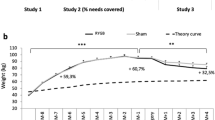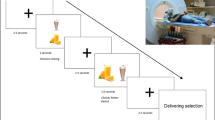Abstract
Objective:
Food intake is regulated by factors that modulate caloric requirements as well as food's reinforcing properties. In this study, we measured brain glucose utilization to an olfactory stimulus (bacon scent), and we examined the role of food restriction and genetic predisposition to obesity on such brain metabolic activity.
Methods:
Zucker obese (Ob) and lean (Le) rats were divided into four groups: (1) Ob ad-libitum fed, (2) Ob food restricted (70% of ad libitum), (3) Le ad-libitum fed and (4) Le food restricted. Rats were scanned using μ-positron emission tomography and 2-[18F]-fluoro-2-deoxy-D-glucose under two conditions: (1) baseline scan (no stimulation) and (2) challenge scan (food stimulation, FS).
Results:
FS resulted in deactivation of the right and left hippocampus. Ob rats showed greater changes with FS than Le rats (deactivation of hippocampus and activation of the medial thalamus) and Ob but not Le animals deactivated the frontal cortex and activated the superior colliculus. Access to food resulted in an opposite pattern of metabolic changes to the food stimuli in olfactory nucleus (deactivated in unrestricted and activated in restricted) and in right insular/parietal cortex (activated in unrestricted and deactivated in restricted). In addition, restricted but not unrestricted animals activated the medial thalamus.
Conclusions:
The greater changes in the Ob rats suggest that leptin modulates the regional brain responses to a familiar food stimulus. Similarly, the differences in the pattern of responses with food restriction suggest that FS is influenced by access to food conditions. The main changes with FS occurred in the hippocampus, a region involved in memory, the insular cortex, a region involved with interoception (perception of internal sensations), the medial thalamus (region involved in alertness) and in regions involved with sensory perception (olfactory bulb, olfactory nucleus, occipital cortex, superior colliculus and parietal cortex), which corroborates their relevance in the perception of food.
This is a preview of subscription content, access via your institution
Access options
Subscribe to this journal
Receive 12 print issues and online access
$259.00 per year
only $21.58 per issue
Buy this article
- Purchase on Springer Link
- Instant access to full article PDF
Prices may be subject to local taxes which are calculated during checkout




Similar content being viewed by others
References
Rohner-Jeanrenaud F, Jeanrenaud B . The discovery of leptin and its impact in the understanding of obesity. Eur J Endocrinol 1996; 135: 649–650.
Levitsky DA . The non-regulation of food intake in humans: hope for reversing the epidemic of obesity. Physiol Behav 2005; 86: 623–632.
Schwartz M, Woods S, Porte DJ, Seeley R, Baskin D . Central nervous system control of food intake. Nature 2000; 404: 661–671.
Wang GJ, Volkow ND, Thanos PK, Fowler JS . Similarity between obesity and drug addiction as assessed by neurofunctional imaging: a concept review. J Addict Dis 2004; 23: 39–53.
Patel KA, Schlundt DG . Impact of moods and social context on eating behavior. Appetite 2001; 36: 111–118.
Arana FS, Parkinson JA, Hinton E, Holland AJ, Owen AM, Roberts AC . Dissociable contributions of the human amygdala and orbitofrontal cortex to incentive motivation and goal selection. J Neurosci 2003; 23: 9632–9638.
Wang GJ, Volkow ND, Felder C, Fowler JS, Levy AV, Pappas NR et al. Enhanced resting activity of the oral somatosensory cortex in obese subjects. Neuroreport 2002; 13: 1151–1155.
Bassareo V, Di Chiara G . Differential responsiveness of dopamine transmission to food-stimuli in nucleus accumbens shell/core compartments. Neuroscience 1999; 89: 637–641.
Pomonis JD, Jewett DC, Kotz CM, Briggs JE, Billington CJ, Levine AS . Sucrose consumption increases naloxone-induced c-Fos immunoreactivity in limbic forebrain. Am J Physiol Regul Integr Comp Physiol 2000; 278: R712–R719.
Berridge KC, Robinson TE . Parsing reward. Trends Neurosci 2003; 26: 507–513.
Phillips MS, Liu Q, Hammond HA, Dugan V, Hey PJ, Caskey CJ et al. Leptin receptor missense mutation in the fatty Zucker rat. Nat Genet 1996; 13: 18–19.
York DA, Godbole V . Effect of adrenalectomy on obese ‘fatty’ rats. Horm Metab Res 1979; 11: 646.
Soto M, Vaquero J, Pascau J, Gispert J, Desco M . Validation of SPM analysis of visual activation in rat brain PET studies. Mol Imaging Biol 2004; 6: 78.
NAS, NRC. Guide for the Care and Use of Laboratory Animals. National Academy Press: Washington DC, 1996.
Woods RP, Grafton ST, Holmes CJ, Cherry SR, Mazziotta JC . Automated image registration: I. general methods and intrasubject, intramodality validation. J Comput Assist Tomogr 1998; 22: 139–152.
Wang GJ, Volkow ND, Telang F, Jayne M, Ma J, Rao M et al. Exposure to appetitive food stimuli markedly activates the human brain. Neuroimage 2004; 21: 1790–1797.
Li XL, Aou S, Oomura Y, Hori N, Fukunaga K, Hori T . Impairment of long-term potentiation and spatial memory in leptin receptor-deficient rodents. Neuroscience 2002; 113: 607–615.
Harvey J . Leptin: a diverse regulator of neuronal function. J Neurochem 2007; 100: 307–313.
Oomura Y, Hori N, Shiraishi T, Fukunaga K, Takeda H, Tsuji M et al. Leptin facilitates learning and memory performance and enhances hippocampal CA1 long-term potentiation and CaMK II phosphorylation in rats. Peptides 2006; 27: 2738–2749.
Lister JP, Tonkiss J, Blatt GJ, Kemper TL, DeBassio WA, Galler JR et al. Asymmetry of neuron numbers in the hippocampal formation of prenatally malnourished and normally nourished rats: a stereological investigation. Hippocampus 2006; 16: 946–958.
Baicy K, London ED, Monterosso J, Wong ML, Delibasi T, Sharma A et al. Leptin replacement alters brain response to food cues in genetically leptin-deficient adults. Proc Natl Acad Sci USA 2007; 104: 18276–18279.
Hoebel BG . Neuroscience and appetitive behavior research: 25 years. Appetite 1997; 29: 119–133.
Ritter S . Multiple metabolic controls of feeding. Appetite 1994; 23: 199.
Travers JB, Travers SP, Norgren R . Gustatory neural processing in the hindbrain. Annu Rev Neurosci 1987; 10: 595–632.
Cameron OG . Interoception: the inside story—a model for psychosomatic processes. Psychosom Med 2001; 63: 697–710.
Yefet K, Merhav M, Kuulmann-Vander S, Elkobi A, Belelovsky K, Jacobson-Pick S et al. Different signal transduction cascades are activated simultaneously in the rat insular cortex and hippocampus following novel taste learning. Eur J Neurosci 2006; 24: 1434–1442.
Berthoud HR . Neural systems controlling food intake and energy balance in the modern world. Curr Opin Clin Nutr Metab Care 2003; 6: 615–620.
Benedict L, Nelson CA, Schunk E, Sullwold K, Seaquist ER . Effect of insulin on the brain activity obtained during visual and memory tasks in healthy human subjects. Neuroendocrinology 2006; 83: 20–26.
Wang GJ, Yang J, Volkow ND, Telang F, Ma Y, Zhu W et al. Gastric stimulation in obese subjects activates the hippocampus and other regions involved in brain reward circuitry. Proc Natl Acad Sci USA 2006; 103: 15641–15645.
Wang GJ, Tomasi D, Backus W, Wang R, Telang F, Geliebter A et al. Gastric distention activates satiety circuitry in the human brain. Neuroimage 2008; 39: 1824–1831.
Healy SD, de Kort SR, Clayton NS . The hippocampus, spatial memory and food hoarding: a puzzle revisited. Trends Ecol Evol 2005; 20: 17–22.
Davidson TL, Kanoski SE, Walls EK, Jarrard LE . Memory inhibition and energy regulation. Physiol Behav 2005; 86: 731–746.
Farr SA, Banks WA, Uezu K, Gaskin FS, Morley JE . DHEAS improves learning and memory in aged SAMP8 mice but not in diabetic mice. Life Sci 2004; 75: 2775–2785.
Biessels GJ, Bravenboer B, Gispen WH . Glucose, insulin and the brain: modulation of cognition and synaptic plasticity in health and disease: a preface. Eur J Pharmacol 2004; 490: 1–4.
Messier C . Glucose improvement of memory: a review. Eur J Pharmacol 2004; 490: 33–57.
Winocur G, Greenwood CE, Piroli GG, Grillo CA, Reznikov LR, Reagan LP et al. Memory impairment in obese Zucker rats: an investigation of cognitive function in an animal model of insulin resistance and obesity. Behav Neurosci 2005; 119: 1389–1395.
Shen F, Meredith GE, Napier TC . Amphetamine-induced place preference and conditioned motor sensitization requires activation of tyrosine kinase receptors in the hippocampus. J Neurosci 2006; 26: 11041–11051.
Comoli E, Coizet V, Boyes J, Bolam JP, Canteras NS, Quirk RH et al. A direct projection from superior colliculus to substantia nigra for detecting salient visual events. Nat Neurosci 2003; 6: 974–980.
Boulenguez P, Foreman N, Chauveau J, Segu L, Buhot MC . Distractibility and locomotor activity in rat following intra-collicular injection of a serotonin 1B-1D agonist. Behav brain res 1995; 67: 229–239.
Holmes NP, Spence C . Multisensory integration: space, time and superadditivity. Curr Biol 2005; 15: R762–R764.
Acknowledgements
This work was supported by the NIAAA Intramural Research Program (AA 11034 and AA07574, AA07611) and by the US Department of Energy under contract DE-AC02-98CH10886.
Author information
Authors and Affiliations
Corresponding author
Rights and permissions
About this article
Cite this article
Thanos, P., Michaelides, M., Gispert, JD. et al. Differences in response to food stimuli in a rat model of obesity: in-vivo assessment of brain glucose metabolism. Int J Obes 32, 1171–1179 (2008). https://doi.org/10.1038/ijo.2008.50
Received:
Revised:
Accepted:
Published:
Issue Date:
DOI: https://doi.org/10.1038/ijo.2008.50
Keywords
This article is cited by
-
Striatal Rgs4 regulates feeding and susceptibility to diet-induced obesity
Molecular Psychiatry (2020)
-
Effects of a Ketogenic Diet on [18F]FDG-PET Imaging in a Mouse Model of Lung Cancer
Molecular Imaging and Biology (2019)
-
Response to Deep Brain Stimulation in the Lateral Hypothalamic Area in a Rat Model of Obesity: In Vivo Assessment of Brain Glucose Metabolism
Molecular Imaging and Biology (2014)
-
Enhanced Striatal Dopamine Release During Food Stimulation in Binge Eating Disorder
Obesity (2011)



